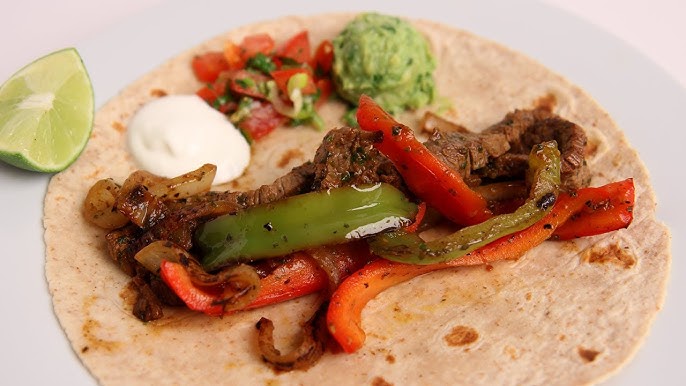Beef Fajitas Recipe: If you’re craving sizzling beef fajitas just like the ones from your favorite Mexican restaurant, you’ve come to the right place. This comprehensive step-by-step guide will walk you through everything you need to know to create juicy, tender, and flavor-packed beef fajitas at home. From choosing the right cut of meat to mastering the marinade and nailing the cook, this recipe is your ultimate ticket to fajita heaven. So grab your skillet and let’s get started!
What Are Beef Fajitas?
Beef fajitas are a Tex-Mex classic that combines strips of marinated beef, sautéed peppers, and onions, all wrapped in a warm tortilla. Traditionally, the dish was made using skirt steak, a cut known for its rich flavor and tenderness when cooked properly. These fajitas are often served with a variety of toppings, such as sour cream, guacamole, salsa, shredded cheese, and fresh cilantro.
The word “fajita” actually comes from the Spanish word “faja,” meaning “belt” or “girdle,” referring to the cut of beef used. Over time, the dish evolved from a simple campfire meal into a restaurant staple, celebrated for its sizzling presentation and mouthwatering aroma. Whether served on a hot skillet or plated with rice and beans, beef fajitas have earned their place in the culinary spotlight.
Why This Recipe Stands Out
There are a lot of fajita recipes out there, but this one delivers the perfect balance of smoky, savory, and slightly tangy flavors. Here’s why this version is a game-changer:
- Authentic Flavors: We stick close to traditional ingredients, ensuring that smoky, citrusy punch.
- Perfect Marinade: This recipe uses a blend of lime juice, garlic, and spices that deeply penetrate the meat for maximum flavor.
- Tender Beef Every Time: With proper marinating and cooking techniques, your beef will be juicy and tender, not chewy.
- Quick & Easy: While it looks and tastes impressive, this recipe is incredibly straightforward and achievable for home cooks of any level.
Ingredients Needed
Let’s get into what you’ll need to pull off the perfect beef fajitas. The ingredients are broken down into three key parts: the marinade, the beef, and the toppings for assembly.
For the Marinade
The marinade is what gives the beef its signature flavor. Here’s what you’ll need:
- 1/4 cup olive oil
- 1/4 cup fresh lime juice (about 2 limes)
- 3 garlic cloves, minced
- 2 tablespoons soy sauce
- 1 tablespoon Worcestershire sauce
- 1 teaspoon ground cumin
- 1 teaspoon smoked paprika
- 1/2 teaspoon chili powder
- 1/2 teaspoon ground black pepper
- 1 teaspoon salt
- Optional: 1 tablespoon honey (for a touch of sweetness)
For the Beef
Skirt steak is the classic cut used for fajitas, but you can also use flank steak or sirloin. Here’s the breakdown:
- 1.5 to 2 pounds of skirt or flank steak
- 2 bell peppers (red and green), sliced
- 1 large onion, sliced
- 2 tablespoons olive oil (for cooking)
For the Fajita Assembly
Once the meat and veggies are cooked, it’s time to bring it all together. Grab these:
- Warm flour tortillas (8-inch)
- Toppings of choice:
- Shredded cheese
- Sour cream
- Guacamole
- Salsa
- Fresh cilantro
- Lime wedges
Preparing the Marinade
Combining the Ingredients
In a large bowl or zip-top bag, combine all marinade ingredients: olive oil, lime juice, garlic, soy sauce, Worcestershire sauce, cumin, paprika, chili powder, salt, pepper, and honey if using. Whisk everything together until well mixed. This mixture should smell tangy and smoky, with just a hint of heat.
Make sure the ingredients are evenly distributed—this ensures every bite of beef will be loaded with flavor. If you’re using a zip-top bag, it’s especially easy to massage the marinade into the meat once the beef is added.
Tips for Maximum Flavor
- Fresh Lime Juice: Always use freshly squeezed lime juice, not bottled. It makes a huge difference in taste.
- Don’t Skip the Garlic: Minced fresh garlic adds a punch that garlic powder just can’t replicate.
- Honey Is Optional but Awesome: A tablespoon of honey can help balance out the acidity and adds a beautiful caramelization when cooking.
- Mix It Right Before Use: Don’t let the marinade sit too long before combining it with the meat. Freshly mixed marinade ingredients interact more effectively with the beef.
Marinating the Beef
How Long to Marinate
Place your chosen beef cut into the marinade and make sure it’s fully coated. Seal the bag or cover the bowl with plastic wrap and place it in the refrigerator. Marinate the beef for at least 2 hours, but for best results, aim for 6 to 8 hours. Overnight is even better if you want the flavors to really infuse.
Avoid marinating for more than 24 hours. The acidic lime juice can start to break down the beef too much, leading to a mushy texture.
Storing While Marinating
Always marinate your beef in the fridge, never on the counter. It’s essential for food safety. If using a bowl, place a plate underneath in case of leaks. And if you’re prepping ahead, label your bag or container with the date and time you started marinating to avoid overdoing it.
Cooking the Beef
Best Cooking Methods
When it’s time to cook, there are a few methods to consider—but whichever you choose, high heat is key. You want a nice sear on the beef to lock in juices and develop flavor.
1. Cast Iron Skillet: This is the top choice. Heat a cast iron skillet over high heat until it’s smoking hot. Add a touch of oil, then sear the steak for about 3-4 minutes per side, depending on thickness. It delivers restaurant-quality results with that unmistakable char.
2. Grill: Another great option, especially if you’re making fajitas for a crowd. Preheat the grill to high. Cook the steak directly over the flames, turning once, until desired doneness is achieved. You’ll get those awesome grill marks and a slightly smoky flavor.
3. Oven Broiler: Not ideal, but if you’re without a grill or skillet, it works in a pinch. Place the steak on a broiler pan and broil close to the heat source for a few minutes per side.
Whichever method you choose, don’t overcrowd the cooking surface. Cook in batches if needed to maintain a high temperature and good sear.
Ideal Internal Temperature
Use a meat thermometer to check doneness. Here’s a guide:
- Rare: 120–125°F
- Medium-rare: 130–135°F (ideal for fajitas)
- Medium: 140–145°F
- Well-done: 155°F+
Once the steak is done, let it rest for 5–10 minutes before slicing. This is crucial—resting allows the juices to redistribute, keeping your steak juicy and flavorful.
Slicing the Beef
How to Slice for Maximum Tenderness
Slicing is just as important as cooking. Always slice against the grain—this means cutting perpendicular to the direction of the muscle fibers. Doing so shortens those fibers and ensures each bite is tender.
Use a sharp knife and slice the steak into thin strips, about 1/4 inch thick. If you’re unsure where the grain runs, look closely at the lines in the meat before cutting. Take your time; this step can make or break your fajitas.
Serving Temperature Tips
Serve the sliced beef immediately, or return it to a warm skillet to keep it hot before assembling the fajitas. If you’re serving buffet-style, consider using a warming tray or slow cooker on low heat to keep the meat tender and juicy until everyone’s ready to dig in.
Sautéing the Vegetables
Choosing the Right Veggies
Classic fajitas use bell peppers and onions, but you can get creative. Here are top veggie picks:
- Red, yellow, green bell peppers (for color and sweetness)
- Yellow or red onions (depending on how strong you want the flavor)
- Jalapeños (if you want a spicy kick)
- Mushrooms or zucchini (optional but delicious additions)
Cooking Method
Use the same skillet you cooked the beef in for maximum flavor. Add a little oil, then throw in your sliced onions and peppers. Cook over medium-high heat, stirring occasionally, until they’re soft and slightly caramelized—about 6–8 minutes.
For an extra layer of flavor, deglaze the pan with a splash of lime juice or a bit of beef broth. This helps lift all those tasty brown bits from the bottom and coats the veggies in rich, beefy flavor.
Assembling the Fajitas
Warm Your Tortillas
Never serve fajitas with cold tortillas. Wrap them in foil and warm them in the oven at 350°F for 10 minutes or heat them individually in a dry skillet for about 30 seconds per side. You can also microwave them wrapped in a damp paper towel.
Layering Like a Pro
Here’s how to build a next-level fajita:
- Start with the tortilla – soft and warm.
- Add a few slices of beef – make sure it’s juicy and hot.
- Pile on the veggies – go for a colorful mix.
- Top it off with your favorite extras – shredded cheese, sour cream, guac, salsa, cilantro, and a fresh squeeze of lime.
Serve with Mexican rice, refried beans, or a fresh side salad to round out the meal.
Tips for Perfect Fajitas Every Time
Common Mistakes to Avoid
Even the best cooks slip up. Here’s what to steer clear of:
- Overcooking the beef – leads to dryness and toughness.
- Not slicing against the grain – makes the meat chewy.
- Skipping the marinade time – sacrifices depth of flavor.
- Cooking veggies too long – they should be tender, not mushy.
- Using cold tortillas – they’ll tear and dull the experience.
Bonus Hacks
- Use a meat mallet to tenderize your steak before marinating.
- Add a splash of beer to your marinade for added depth.
- Double your batch and freeze half the cooked beef and veggies for a quick meal later.
Fajita Toppings & Extras
Toppings That Elevate the Flavor
The right toppings can turn great fajitas into unforgettable ones. While beef, peppers, and onions form the foundation, your toppings are what give the dish personality and depth.
Here are the best options to take your fajitas over the top:
- Sour Cream: Adds a creamy, tangy contrast to the savory meat.
- Guacamole or Sliced Avocado: Creamy and rich, it balances the spice.
- Fresh Pico de Gallo: Brings a refreshing crunch and acidity.
- Shredded Cheese: Cheddar, Monterey Jack, or a Mexican blend all work great.
- Jalapeños or Hot Sauce: For heat lovers, a must-have.
- Fresh Cilantro: Adds a burst of herby freshness.
- Lime Wedges: A final squeeze brightens every bite.
Don’t overload your tortilla though. Aim for a good balance—enough to enjoy every component, but not so much that your tortilla can’t hold it all.
Side Dishes to Serve With Fajitas
You can’t go wrong pairing your fajitas with classic Mexican sides. Here are some favorites:
- Mexican Rice or Cilantro Lime Rice
- Refried Beans or Black Beans
- Elote (Mexican Street Corn)
- Chips & Salsa or Queso
- Simple Side Salad with Lime Vinaigrette
These sides not only complement the flavors but also turn your fajitas into a full-blown fiesta.
Storing and Reheating Leftovers
Storage Tips
If you end up with leftovers (which is rare!), store them properly to keep them tasting great the next day.
- Beef and Veggies: Store in an airtight container in the fridge for up to 4 days.
- Tortillas: Keep in their original packaging or wrapped in foil.
- Toppings: Store individually in small containers to maintain freshness.
Reheating the Right Way
- Skillet: Add a splash of water or broth and heat on medium until warm.
- Microwave: Heat in 30-second bursts, covered with a damp paper towel to prevent drying out.
- Oven: Wrap in foil and warm at 300°F for about 10–12 minutes.
Avoid reheating multiple times. Only heat what you plan to eat to preserve the best taste and texture.
Make-Ahead and Freezer Tips
Meal Prep Friendly
Beef fajitas are a meal-prepper’s dream. You can chop your veggies, prepare your marinade, and even cook everything in advance if needed.
- Marinate Beef Ahead: Mix and marinate the day before.
- Pre-Cut Veggies: Store in zip-top bags or containers for quick sautéing.
- Store-Cooked Beef: Will keep in the fridge for 3–4 days, perfect for weekday lunches.
Freezing Instructions
- Raw Marinated Beef: Freeze in marinade for up to 3 months. Thaw overnight before cooking.
- Cooked Beef and Veggies: Freeze in portioned containers. Reheat for a quick dinner or lunch.
- Tortillas: Freeze with wax paper between each to prevent sticking.
When you’re ready to eat, just heat and assemble. It’s like having a gourmet meal ready to go in minutes.
Nutrition Facts and Dietary Info
Healthier Fajita Options
Beef fajitas can be part of a healthy diet if you build them smartly:
- Lean Cuts: Opt for leaner cuts like flank steak.
- Use Whole Wheat Tortillas: More fiber, fewer carbs.
- Load Up on Veggies: More nutrients, fewer calories.
- Skip or Lighten the Cheese and Sour Cream: Or use light versions.
- Grill Instead of Fry: Cut down on oil usage.
Nutrition Breakdown (Per Serving)
Here’s an approximate nutritional snapshot (based on one fajita with beef, veggies, tortilla, and basic toppings):
- Calories: 320
- Protein: 22g
- Carbs: 25g
- Fat: 15g
- Fiber: 3g
- Sodium: 680mg
These numbers can vary based on ingredients and portions, but it gives you a general idea of what to expect.
FAQs about Beef Fajitas Recipe
1. What cut of beef is best for fajitas?
Skirt steak or flank steak are the top picks for beef fajitas. They’re flavorful, tender when sliced thinly, and cook quickly—perfect for a sizzling fajita night!
2. How long should I marinate the beef?
For bold, juicy flavor, marinate the beef for at least 1 hour, but for best results, leave it in the fridge overnight. Avoid over-marinating (more than 24 hours) to prevent mushy texture.
3. Can I make beef fajitas without a grill?
Absolutely. A cast-iron skillet or grill pan on your stovetop works wonders. Get it smoking hot, then sear the beef until beautifully charred.
4. What toppings go on beef fajitas?
Classic toppings include sautéed bell peppers and onions, guacamole, sour cream, salsa, cheese, and a squeeze of fresh lime juice.
5. Are beef fajitas spicy?
That depends on your marinade and seasoning. Most are mild to medium, but you can spice things up with chili powder, jalapeños, or hot sauce.
6. Can I meal prep beef fajitas?
Yes! You can slice and marinate the beef ahead of time, store chopped veggies, and even cook the fajitas and reheat them throughout the week for quick, protein-packed meals.
7. What side dishes go with beef fajitas?
Popular sides include Mexican rice, refried beans, corn on the cob, or even a fresh avocado salad. Want to keep it low-carb? Try cauliflower rice.
8. Can I freeze beef fajitas?
Yes, both uncooked marinated beef and fully cooked fajitas freeze well. Store in airtight containers or freezer bags for up to 3 months.
9. Are beef fajitas healthy?
They can be! Opt for lean cuts, use minimal oil, load up on veggies, and serve in whole wheat tortillas or lettuce wraps for a healthy twist.
10. What’s the best way to reheat beef fajitas?
Reheat in a hot skillet for a few minutes or use the microwave if you’re in a rush. Be careful not to overcook the beef to keep it tender.
Conclusion
Beef fajitas are more than just a meal—they’re an experience. From the sound of the sizzle to the rich aroma and bold flavors, everything about this dish screams satisfaction. With the right cut of beef, a flavorful marinade, and just a few cooking tips, you’ll be whipping up restaurant-quality fajitas in your own kitchen in no time.
Whether you’re cooking for family, impressing guests, or meal-prepping for the week, this step-by-step guide ensures your fajitas will always hit the mark. So heat up that skillet, grab some tortillas, and get ready to wow everyone at your table.



